D.D.A.P.S Club History from the Beginning
Brooklands History
The Society was formed on 9 April 1931 the name chosen was the Dartford Piscatorial Society.
In January 1932 the club’s name was changed to Dartford & District Angling & Preservation Society.
At the time the club’s home water was Ellingham’s Ponds – now Brooklands Lakes. One of the founder members of the club, not surprisingly was Mr Ellingham. He owned an aggregates company who extracted gravel from what later became the ponds. In a splendid gesture during his lifetime he gave the fishing rights free to DDAPS. Upon his death the lakes reverted to the control of the Dartford Borough Council and DDAPS has leased the lakes from the Council ever since.
As a fishery, Brooklands was thriving before the Second World War, and during the hostilities a popular rumour indicates the lakes were completely covered in camouflage netting to conceal them from enemy aircraft which could have used the water as a landmark when attacking nearby munitions factories.
Brooklands was stocked with carp from way back – even before the old Kent River Board introduced tens of thousands of small carp throughout the county of Kent making it a few short years into the nick-name of ‘carp county’. By the late 1950s some of the Brooklands carp had grown into big fish.
As far as I can ascertain in August 1960 one of the first recorded 20-pounders was landed by Laurie Zurcher at 22lb – I once met Laurie at an early British Carp Study Group meeting around 1970 and remember him telling me of his success that season at Brooklands with a string of decent double-figure carp to 18lb. Soon after at the lake a 21¼lb mirror was banked by Len Hamilton, this in turn was followed by another perhaps different mirror of 21¼lb netted by John Miller. The following year a 15-year-old lad, Paul Cheek, also landed 21¼lb mirror. Clearly there were a number of carp that had grown over the magical twenty-pound mark – a rare beastie in those days.
Another early angler of note to taste success at Brooklands in 1960 was the redoubtable Bob Buteux. His introduction to the lake is somewhat amusing.
It was still pitch dark when Bob pulled into a parking space near the water; he was not even sure it was Brooklands. Complete with his tackle he walked along an uncertain path that ran by the edge of the water and eventually found an angler crouched over his rod.
Bob asked, “Excuse me, mate, is this Brooklands?”
The angler looked around briefly.
“That’s right,” he replied.
“Got some good carp in, has it?” Bob ventured.
“That’s right,” he again said, and with that reached out and lifted his keepnet. “Are they big enough for you?” Bob stared in the gloom at two large, dark shapes in the net.
“How big?” He asked eagerly.
“Best one is sixteen.”
Bob stared in silence for what seemed minutes, and then as if reading his mind, the angler said, “Floating crust”.
Some small carp were caught by Bob on that trip and all fired up he returned early the following morning. With trembling hands, he baited a two-inch square of crust on the number two hook, and crouching low, steadied himself. Suddenly a big fish moved close… and Bob dropped a crust close to it. Almost immediately, amid a mighty swirl, the bait was taken. His split cane Mk IV carp rod was soon creaking (and so was Bob) the power of fish indicating that it must be a good’un.
Eventually and with some effort he got the net under the fish. Years ago Bob told me, “It was the biggest fish I had ever seen, and looked so fat I thought if it grew any bigger it would burst. On my brand new 30lb balance it weighed 20lb 4oz.” It was a notable achievement and at that weight would have entered the top twenty carp captures recorded in 1960.
Bob Buteux holds his 20lb 4oz mirror, one of the first twenty-pounders from Brooklands
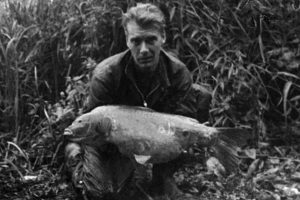
Lenny Savage of the West Essex Specimen Hunters Group in 1961 with a heavily plated double-figure Brooklands mirror
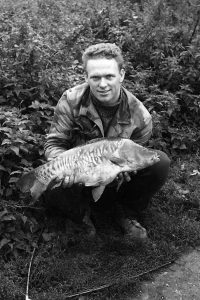
The Good & Great
An insight into the how good the fishing could be at Brooklands in the mid-1960s was documented by no less a carp luminary than Jack Hilton, who wrote of it under the synonym of Goodwood lake. In his classic ‘Quest for Carp’ book he tells us, “Goodwood Lake had treated me very well. During the first full season I fished there (1964) I had been fortunate enough to take thirty-six carp in all, twenty-three of them being 10lb and over, and doubling the number of double-figure carp that I had taken during several seasons in the past at other venues.”
The mighty Jack Hilton with a 14½lb Brooklands mirror caught on potato in October 1966
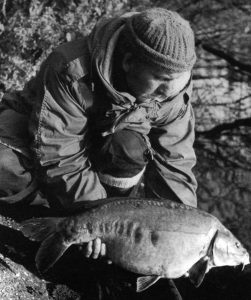
This mid-1960s period was the glory years for the bigger fish of Brooklands. On record is a Mr Llewellyn with a 21-pounder, my old mate Ken Rowley with another 21lb mirror, Pete Miller with a 24lb, the noted Bill Quinlain with a 24¾lb and topped by fish of 26lb and 26½lb to Gerry Savage. I’ve a sneaking suspicion the last quartet were the same fish.
In the late 1960s bait genius Fred Wilton baited Brooklands with his excellent PYM (Phillips Yeast Mixture – a conditioner used in pigeon rearing) high nutritional value based bait and although results were initially slow PYM caught a huge number of carp for those ‘in the know’ over the following seasons.
Other top names of the carp world fished the lake at the time including Jim Gibbinson – on one of my trips I saw Jim pack up and then strap one-piece 11ft carp rods to the roof rack of his van. Others included the great Fred Wilton, Roger Smith, Kenny Ewington, Lenny Savage, Bob Hornegold, the late Steve Edwards along with Ron Gould, Bob Rolph, Dave Cruickhank, Ron Blackmore, Alf Engers, Pete Badley, Dave Hayes, Graham Igglesdon, Tom and Mike Mintram, Pete Cranstoun, Keith Dickens, Graham Stephens, the late Chris Haswell, Bob Morris, Cliff Webb, Derek Stritton, Andy Spreadbury, Pete Handley, Paul Snepp, Robin Monday, Mick Fisher, Mick ‘Curly’ Hatchman and a host of others.
Personal experience
Amid the rise of Brooklands as a major carp water I was lucky to visit and catch a Brooklands carp myself. This was in the summer of 1968, being taken to the water by Dave Rudd, a carp angler of my age who I’d met at The National Angling Show in London the year before and had fished with Dave at Horton Kirby and Bysingwood.
Situated adjacent to the A225 Princes Road, just south of Dartford, Brooklands Lake offered an easily accessible angling retreat. For less than a 10/- (50p) for a day-ticket (no night fishing allowed, though this was little policed at the time) it represented good value.
At that time Brooklands was split into four definable areas covering around 17-acres interconnected by channels. From the southern Powdermill Lane car park to the right you had Baldwins Lake with its famous ‘Ashes’ area. Also prominent was a small bridge which connected the bank to what was called the Centre Path, a long thin landmass that eventually connected to the northern bank. It was under the small bridge travelling westwards that the water opened out into what was then called Powdermill Lake. In turn this area of water led off to the left though a narrow gap into the Slaughterhouse Bay and finally to the right between an island and the centre path was the A2 Lake. It seemed that all the banks were accessible, except for a Sea Scout area known as ‘The Anson’ on the banks of the A2 Lake.
Along with several others who I spied as the light faded, we illegally night fished over a very warm Friday night and by the early morning I’d hooked and landed a 12lb mirror. It was while the mist was still on the water that I noticed three anglers turn up and cast out from ‘The Ashes’ which was away to the left of the swim Dave Rudd and I fished.
Before long one of the trio rushed to his rod, struck and a strong battle enthused. After 10-minutes or so Dave suggested we’d better go and see what was causing such a long protracted fight.
It’s still a sight 50-years later I remember quite clearly. The carp was a monster, so much so it almost frightened me – I kid you not. When weighed the classic-shaped mirror pulled the scales down to 23lb. I raced off for my camera and duly took a few pictures – it would be years before my net would eventually engulf a similar sized specimen.
Throughout the 1980s the lake and its occupants still drew many to its banks, and 20-pounders were caught in quantity even through the surroundings had changed – buildings demolished and at least one new trading estate built, but I believe the essence of the place was still there.
A return
Around the mid-1990s I was booked to do a carp fishing slide show in the locality and leaving home early I was intent on visiting the lake for old time’s sake. Sure enough I found the Powdermill Lane entrance and parking the car up was soon wandering along the Baldwins bank. Blimey, the bankside vegetation and trees were almost unrecognisable with the passing of time. This is hardly surprising for it was around 25-years since I last trod the banks of Brooklands Lake. I soon reached a swim that was in the approximate spot where I’d fished that first night with Dave Rudd in 1968. I peered over towards the ‘Ashes’ – like many lakes I’ve returned to years later the distance of certain things be it islands, the size of bays, etc. seem nowhere near as far or as big as I remember from the past – for the Ashes seemed to be ‘just over there’ as I looked. A carp angler was in the next swim intently surveying the water out in front, he nodded as I quietly wandered past. 10-minutes later on my return I passed him again only this time he was stuck fast into a fish. I watched from a distance until the fish was kicking in the landing net. At a tad under 20lb he was pleased and asked if I could take some pictures on his 35mm film camera.
Imagine my surprise (and delight) when later in the evening during the half-time break in the slide show – a voice behind me said, “Let me buy you a drink, after all I owe you one for taking those pictures.” The Brooklands carp angler from earlier turned out to be nice chap named Tyler Willis.
Horton Kirby History
There will be many carp anglers up and down the country who will be acquainted with a set of gravel pits under the collective name of Horton Kirby which are situated just north of the village of the same name in the heart of Kent. For some years starting in the late 1950s and through the following decade the disused gravel pit workings were owned by the Horton Kirby Sand and Ballast Company. They ran an angling club where fishing was conducted on a day ticket basis though at the time there was no night fishing. For the princely sum of 2s 6d (12½p) anyone could enjoy a day’s fishing. Later in 1971 the Dartford and District Angling and Preservation Society purchased Horton Kirby and have looked after it ever since.
Along with many other still waters, rivers and canals, Horton Kirby benefited from the stocking policy of the influential Kent River Board who masterminded the introduction of in excess of 80,000 carp from the late 1950s through to the early 1970s. Prior to this some of the very early introductions in Kent were from Donald Leney of the Surrey Trout Farm, but later in quite a bold move the KRB imported directly from Italy thousands upon thousands of 4-6in carp, some of these were destined for Horton Kirby.
The rich pickings of a comparatively young set of gravel pits were certainly utilised by the tiny carp and they grew at an alarming rate. Early reports plus information gleaned from friends indicate that you were more likely to catch a carp over 10lb than under by the mid-1960s at Horton Kirby.
The lower lake, around 10-acres, became the main carp water and was fished by all and sundry included people who were later to make their mark on carp fishing (and other occupations.) The closeness of the Farningham Road railway station also made it a venue that appealed to anglers who lived further away and there are many tales of hurriedly catching the train to fish Horton Kirby and of course trying to make sure not to miss the last train home (carp dependent of course.) I’ve mentioned that night fishing was not permitted, but this didn’t stop the more adventuresome carpers from chancing their arm and fishing overnight. It appears bailiffs were in short supply in the early 1960s. However, at some stage in the mid-1960s this must have changed for there are reports in magazine articles and books of fishing overnight at Horton Kirby from around 1964 onwards.
The availability of good quality carp fishing early on at ‘Kirby’ drew some notables including Jim Gibbinson who enjoyed many multiple catches as did a name that became synonymous with Horton Kirby, the late Gerry Savage. Both Jim and Gerry plus others enjoyed catches that were far and away greater than anywhere else in the country at the time. Anchored crust became a winning method at the lake. It was a period of fiberglass rods such as the Hardy Gordon’s, Davenport & Fordham’s ‘Farstrike’, the Tag Barnes ‘Supercarp’ or B. James & Son MkIV G rods. Mitchell, Intrepid and Ambidex reels were in use along with Platil, Slycast or Maxima monofil line and Sealey Speedbarb or Chapman Goldstrike and later Au Lion D’Or 1534 hooks.
Both Jim Gibbinson and Gerry Savage wrote numerous articles on catching carp in the late 1960s and early 1970s and often the accompanying photographs were taken at Horton Kirby.
The fishery also played an important part in the development of winter carp fishing in lakes that were unaffected in any way by a warm water influence (such as the Electricity Cut at Peterborough and other selected power station outfalls.)
Cold Carping
In November 1966 some members in the Essex Specimen Group along with a few friends from the Kent Specimen Group decided to concentrate their efforts on carp fishing until the end of the season. They chose Horton Kirby mainly because they felt there was less likelihood of the fish disappearing into the mud, they could only lie on the bottom of the lake on the gravel, and as soon as a warm spell came they would soon be moving again.
By Christmas they had landed 20 carp including eight over 10lb. They kept telling themselves that it was a mild winter, quite amazed by their successes. At one of the group meetings they all brought along previous fishing diaries to compare water temperatures of latter years with temperatures of the 1966/7 season. There was no difference at all, if anything it was colder than the previous winter.
The only discomfort, of course, was the cold and on several nights the group recorded air temperatures down the 24º F and even dodges such as glycerine wiped on rod rings wouldn’t beat Jack Frost.
The garments available to anglers during this period were abysmal, there were no such things as insulated one-piece suits, moon boots or mega warm sleeping bags. The standard issue outfit wore by these hardy souls was either ex-army tank suits with piles of clothing underneath or heavy clothing under an equally heavy-duty ‘Parka’ coat. A hat, scarf, gloves and balaclavas were also essential items.
Baits were still pheasant egg size often sausage meat mixed and breadcrumbs or groundbait and of course the bait was impaled directly onto the hook – this being well over a decade before the advent of the hair rig.
During January, February and March this group of anglers recorded temperatures between 36ºF and 43ºF, and yet another 27 carp were chalked up with eight over 10lb.
Towards the end of the season, on the 11th/12th March Jim Gibbinson joined the winter carpers at Horton Kirby. He wrote about this session in 1968.
“At the time of writing there is one barrier to overcome – for me it is something of a psychological barrier – the first winter “twenty”. It is my ambition, just as it is the ambition of every winter carp enthusiast with whom I have been in touch, to catch the first authenticated 20lb carp by deliberate carp fishing in winter in water unaffected by warm water influence. (Archie Braddock and Jack Hilton were some of the first to do this in 1967 & 1971 respectively.)
Last season we came very near – in fact it is possible that I may have actually done it… let me explain. I was fishing one night in early March in absolutely atrocious conditions – there was a gale, snow, sleet, hail and rain; yes, all in one night!
“Fishing was very difficult indeed and most uncomfortable. It was a night when the elements went wild. Despite the conditions I had high hopes for a carp – hopes that promised to become reality when at 11pm one of the buzzers sounded.
“It is strange how that sound galvanizes one into action! Almost automatically the blankets were pulled to one side; I placed a leg on the ground to support my weight, picked up the rod, closed the pick-up, waited for the line to draw tight then struck hard. Winding the rod down to the horizontal I struck again – for I was fishing at very long range.
“The last strike saw me with the rod held high, while I was leaning right back as far as my bed-chair would allow. The thumps that travelled up the line left me in no doubt that a carp had been hooked and after 10-minutes or so it was wallowing over the net. Soon I was clambering up the muddy slippery banks – net and carp in one hand, rod in the other.
“Before pausing to look at the fish I unhooked it – it was a big fish, which was obvious. I estimated it to be about 18lb, a mirror, and then put it in the sack to be weighed and photographed at dawn. I should have weighed it there and then – for when the dawn came it was miserable and overcast and I decided to wait until the light improved before weighing and photographing the fish.
“That was how the fish came to be weighed 12-hours after capture, at about 11am – the needle went a shade over 19lb! Photographs were taken, the fish was measured, and then it was returned to the water. I wondered then as I wonder now if that fish was a “twenty” when caught.
Jim Gibbinson with his 19-pounder Horton Kirby mirror caught on 11th March 1966.
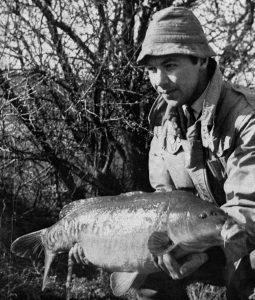
“It is of no matter of course, merely of academic interest now: perhaps it is just as well that I do not know the answer! This “winter twenty” matters a great deal, though for goodness’ sake I’m not sure why it should. But it does. Not because we have not caught twenties – almost all of my immediate circle of carp fishing friends have, as I have, carp of over 20lb to their credit.
“The following night was rather less inclement – the gale still blew but the rain, sleet, hail and snow had stopped. I caught a 12-pounder that night that gave me one of the hardest fights I have ever had from any carp of any weight. At one stage I became convinced that it must be a foul-hooked fish; not so however. It was a deep-bodied mirror carp that was hooked in the mouth – what a fighter though! It made the 19lb fish taken the previous night seem very slow by comparison.
“So, I missed the winter twenty by a pound last season, and perhaps a slight error of judgment. However, no matter – this winter I shall be trying again, as will more carp anglers than ever before, judging by the amount of interest that is now shown in winter carp fishing. I suspect that not one but several twenties will be taken this winter. I’m not greedy – I only want the first!”
Dave Rudd with an early winter Horton Kirby mid double from the mid-1960s.
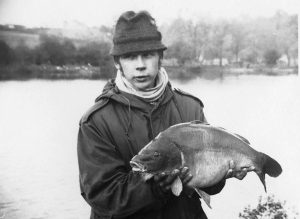
Around this time there were plenty of young carp anglers about like the late Chris Haswell, Ken Rowley, Steve Edwards, John Probert, Dave Rudd, Pete Badley, Dave Hayes, Mick Baldry, John Merriman, Graham Stevens, Grahame Igglesden, Bob Rolph, Keith Dickens, Dave Cruikshank, Ron Gould, Pete Cranston, Bernie Cooke, Alf Engers, Colin Claydon, Rod Hutchinson, entertainer Jim Davidson, (an ardent carp angler), plus many others.
Years back Jim Davidson wrote about Horton Kirby, “I had my first 20-pounder from Horton Kirby in 1968. It was where my dad had taken me when I was a kid, which started it all. I saw a guy catch a carp off the surface and that did it. I got my mum to get me a Provident cheque and I bought two 10ft Carpmaster rods and two Mitchell 300s. Of course I sprayed them black and customised my Heron alarms! Before that, indication was by means of a penny on the open spool of my one Mitchell 324 on my ABU Carpmaster rod of 1¾lb test curve. Baits were sausage meat and bread flake mix, moving on to Pomenteg, a type of groundbait, instead of the bread. Those were the days. I was 15-years-old and playing drums in a pub in Woolwich. I’d catch the 11.10pm train to Dartford and walk the 3½ miles to Horton Kirby.”
John Merriman with a glorious 20lb 12oz Horton Kirby mirror from July 1966. This carp was typical of the imported fish from Italy by the Kent River Board over 10-years before.
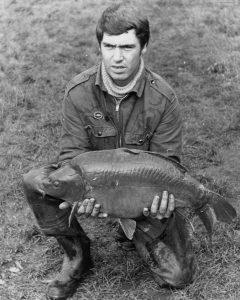
Many things have happened to this part of Kent – take a report from the late 1960s when the local Kent Messenger newspaper reported the whole area surrounding Kirby suffered the worse flood since 1814. However, in a cruel twist of fate, many of the original carp in Horton Kirby were to perish when the lakes virtually dried up in the very hot summers of 1975 and 1976.
These days under the auspices of DDAPS the historic Horton Kirby is a well-stocked series of lakes with plenty of decent carp on offer.
As DDAPS developed, leases were taken out on lakes at Darenth (now Clearwater owned), Devon Road (now Leisure Sport’s Sutton at Hone venue) as well as our current waters at Sutton at Hone and Horton Kirby. Sutton at Hone Lakes was purchased in 1965 with negotiations beginning in1959. Parts of the rivers Beult and lesser Tiese at Chainhurst were purchased in 1965 but the land was sold to the local farmer with the society retaining the fishing rights. Horton Kirby was purchased in 1971 and its current car park in 1978. The leases on both Darenth and Devon Road were lost when Leisure Sport Angling was set up by their owners. In addition the club now leases stretches of the river Medway at Postern Lane Tonbridge and River Beult at New Barn Farm. From a small beginning we now have around 2200 members including some 270 senior citizens.
With thanks to Chris Ball for this research.
